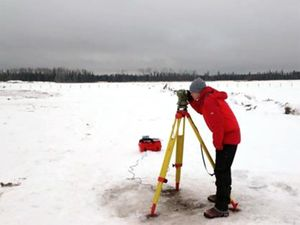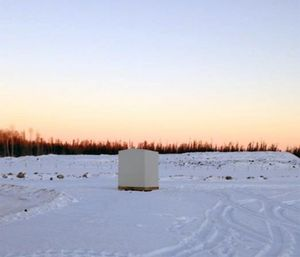OR/16/030 Real-time monitoring established in Alberta, Canada
| Thomson, Alan W P. 2016. Geomagnetism review 2015. British Geological Survey Internal Report, OR/16/030. |


A new absolute geomagnetic observatory has been installed near the town of Fort McMurray in Northern Alberta to provide real-time magnetic measurements as a navigation reference for the directional drilling industry in the region.
As early as 2009, BGS and Halliburton-Sperry Drilling (HSD) started a dialogue to explore the feasibility of establishing a long-term geomagnetic monitoring station in Northern Alberta. The objective of the station would be to provide navigational reference data to the directional drilling industry, supporting oil production in the Fort McMurray region.
For the reference data to be useful, any monitoring station would need to be able to continuously provide data of high absolute accuracy in real-time. In practice this would necessitate the use of very stable instruments, operated in a controlled environment and backed by routine, calibrating reference measurements. These are the conditions necessary for an absolute magnetic observatory as defined by IAGA (Jankowski & Sucksdorff).[1]
Fort McMurray is located at a high geomagnetic latitude, close to the auroral oval, where the external field contribution is large and can cause significant directional uncertainty if not accounted for by the drilling industry. Since the variability of the external field is not readily predictable, it is necessary to monitor as close as possible to the drill site to minimise navigational uncertainty.
Prior to the installation of the Fort McMurray Observatory (FMC), the nearest absolute observatory to the area was the Natural Resources Canada Meanook Observatory (MEA), some 270 km south of Fort McMurray. But by establishing FMC, we are now able to provide a more accurate representation of the natural sources of the local magnetic field (either independently or in conjunction with MEA). FMC will therefore be a valuable long-term local resource when making airborne surveys and taking ground measurements in the region, as well as a source of real-time measurements of the external magnetic field for the drilling industry, through the BGS Interpolation In-Field Reference (IIFR) service.
FMC Observatory has been located on a newly developed HSD site close to the northern Alberta highway 63 at 56° 36' N, and 111° 19' W. Groundwork for the observatory began in late 2014, with the instruments installed in December of that year. Once the absolute levels of the instruments were determined and reliable communications were in place, the observatory came online in early 2015.
One-second tri-axial fluxgate magnetometer and ten-second Overhauser effect proton precession magnetometer measurements, made using a BGS Geomagnetic Data Acquisition System (GDAS), are transferred in real-time to BGS Edinburgh for IIFR processing prior to the data being made available to industry customers via a web interface. The automatic observatory measurements are backed by regular manual D/I theodolite measurements to control the absolute level of the automatic data and FMC has been incorporated into the routine quality control procedures that apply to all BGS IIFR data streams. Typically, FMC IIFR data are available to customers within 3 minutes of recording.
The large amplitude and rapid time variations of the magnetic field in the Fort McMurray region are only part of the challenge of operating an absolute observatory in Northern Alberta. The outside air temperature can be as low as -30°C during winter and as high as +30°C during summer, freezing and thawing the top layers of the 30 m deep muskeg (peat bog). Since the bedrock layer is some 300 m below the surface, the instruments have been stabilised using non-magnetic piles, driven four metres into the ground. The temperature sensitive fluxgate magnetometer is housed within an insulated chamber inside an insulated, weatherproof fibre-glass hut. The operating environment of the fluxgate is maintained at a constant temperature using a custom-made, non-magnetic heater, which is accurately controlled using an adaptable proportional controller.
Magnetic measurements are precisely time-stamped against a Network Time Protocol reference clock and are transferred using parallel, independent communications channels (4G cell and satellite ISP) for reliability.
The observatory instruments were calibrated against transferrable standards, traceable to accredited laboratories in the UK (UKAS) during set-up — a process that will be repeated annually.
References
- ↑ Jankowski, J and Sucksdorff, C. IAGA Guide for Magnetic Measurements and Observatory Practice, 1996, ISBN: 0-9650686-2-5